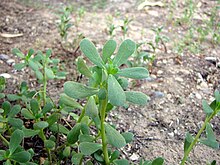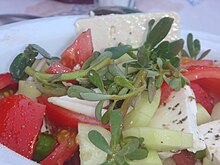
Kohlrabi, also called German turnip or turnip cabbage, is a biennial vegetable, a low, stout cultivar of wild cabbage. It is a cultivar of the same species as cabbage, broccoli, cauliflower, kale, Brussels sprouts, collard greens, Savoy cabbage, and gai lan.
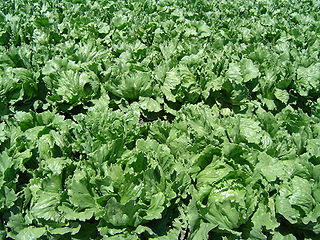
Lettuce is an annual plant of the family Asteraceae. It is most often grown as a leaf vegetable, but sometimes for its stem and seeds. Lettuce is most often used for salads, although it is also seen in other kinds of food, such as soups, sandwiches and wraps; it can also be grilled. One variety, celtuce, is grown for its stems, which are eaten either raw or cooked. In addition to its main use as a leafy green, it has also gathered religious and medicinal significance over centuries of human consumption. Europe and North America originally dominated the market for lettuce, but by the late 20th century the consumption of lettuce had spread throughout the world. As of 2021, world production of lettuce and chicory was 27 million tonnes, 53 percent of which came from China.

The chickpea or chick pea is an annual legume of the family Fabaceae, subfamily Faboideae. Its different types are variously known as gram or Bengal gram, chhana, chana, or channa, garbanzo or garbanzo bean, or Egyptian pea. Chickpea seeds are high in protein. It is one of the earliest cultivated legumes, the oldest archaeological evidence of which was found in Syria.
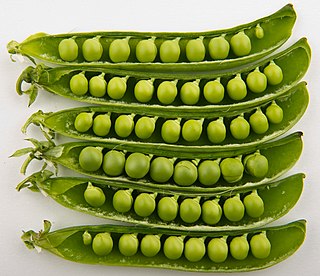
Pea is a pulse, vegetable or fodder crop, but the word often refers to the seed or sometimes the pod of this flowering plant species, formerly 'Pisum sativum', it has been proposed to rename the species as Lathyrus oleraceus. Each pod contains several seeds (peas), which can have green or yellow cotyledons when mature. Botanically, pea pods are fruit, since they contain seeds and develop from the ovary of a (pea) flower. The name is also used to describe other edible seeds from the Fabaceae such as the pigeon pea, the cowpea, the seeds from several species of Lathyrus and is used as a compound form for example Sturt's desert pea.

Spinach is a leafy green flowering plant native to central and Western Asia. It is of the order Caryophyllales, family Amaranthaceae, subfamily Chenopodioideae. Its leaves are a common edible vegetable consumed either fresh, or after storage using preservation techniques by canning, freezing, or dehydration. It may be eaten cooked or raw, and the taste differs considerably; the high oxalate content may be reduced by steaming.

Momordica charantia is a tropical and subtropical vine of the family Cucurbitaceae, widely grown in Asia, Africa, and the Caribbean for its edible fruit. Its many varieties differ substantially in the shape and bitterness of the fruit.
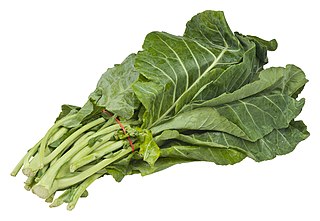
Collard is a group of loose-leafed cultivars of Brassica oleracea, the same species as many common vegetables including cabbage and broccoli. Part of the Acephala (kale) cultivar group, it is also classified as the variety B. oleracea var. viridis.

Kale, also called leaf cabbage, belongs to a group of cabbage cultivars primarily grown for their edible leaves. It has also been used as an ornamental plant.

Cirsium oleraceum, the cabbage thistle or Siberian thistle, is a species of thistle in the genus Cirsium within the family Asteraceae, native to central and eastern Europe and Asia, where it grows in wet lowland soils.

Leaf vegetables, also called leafy greens, pot herbs, vegetable greens, or simply greens, are plant leaves eaten as a vegetable, sometimes accompanied by tender petioles and shoots. Leaf vegetables eaten raw in a salad can be called salad greens.

Butternut squash, known in Australia and New Zealand as butternut pumpkin or gramma, is a type of winter squash that grows on a vine. It has a sweet, nutty taste similar to that of a pumpkin. It has tan-yellow skin and orange fleshy pulp with a compartment of seeds in the blossom end. When ripening, the flesh turns increasingly deep orange due to its rich content of beta-carotene, a provitamin A compound.

Pachyrhizus erosus, commonly known as jícama or Mexican turnip, is a native Mexican vine, although the name jícama most commonly refers to the plant's edible tuberous root. It is in the pea family (Fabaceae). Pachyrhizus tuberosus and Pachyrhizus ahipa are the other two cultivated species in the genus. The naming of this group of edible plants can sometimes be confusing, with much overlap of similar or the same common names.
Purslane is a common name for several mostly unrelated plants with edible leaves and may refer to:

Sonchus oleraceus is a species of flowering plant in the tribe Cichorieae of the family Asteraceae, native to Europe and Western Asia. It has many common names including common sowthistle, sow thistle, smooth sow thistle, annual sow thistle, hare's colwort, hare's thistle, milky tassel, milk thistle. and soft thistle.
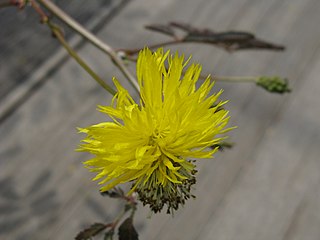
Neptunia oleracea, commonly known in English as water mimosa or sensitive neptunia, is pantropical nitrogen-fixing perennial legume. Genus and common name come from Neptune, god of the sea, in reference to the aquatic habit of some species in the genus.

Roystonea oleracea, sometimes known as the Caribbean royal palm, palmiste, imperial palm or cabbage palm, is a species of palm which is native to the Lesser Antilles, Colombia, Venezuela, and Trinidad and Tobago. It is also reportedly naturalized in Guyana and on the islands of Mauritius and Réunion in the Indian Ocean.

Acmella oleracea is a species of flowering herb in the family Asteraceae. Common names include toothache plant, Szechuan buttons, paracress, jambu, buzz buttons, tingflowers and electric daisy. Its native distribution is unclear, but it is likely derived from a Brazilian Acmella species. A small, erect plant, it grows quickly and bears gold and red inflorescences. It is frost-sensitive but perennial in warmer climates.

This is a categorically-organized list of foods. Food is any substance consumed to provide nutritional support for the body. It is produced either by plants, animals, or fungi, and contains essential nutrients, such as carbohydrates, fats, proteins, vitamins, and minerals. The substance is ingested by an organism and assimilated by the organism's cells in an effort to produce energy, maintain life, or stimulate growth.

Portulaca oleracea subsp. sativa also known as golden purslane is one of few subspecies of Portulaca oleracea.

Spring greens, or spring vegetables, are the edible young leaves or new plant growth of a large number of plants that are most fit for consumption when their newest growth happens in the spring. Many leaf vegetables become less edible as they age and bitter, or potentially even toxic, compounds start to form. Harvesting of spring vegetables is common across Native American cultures.
